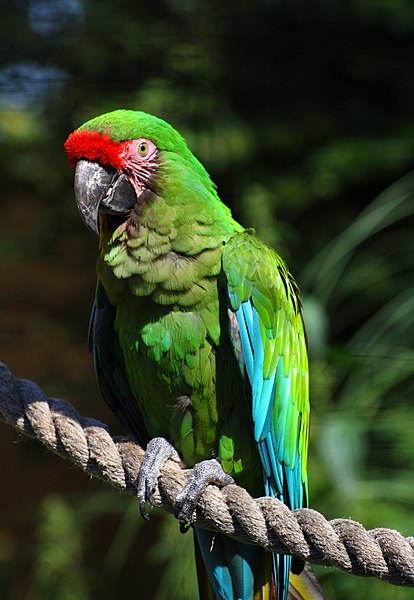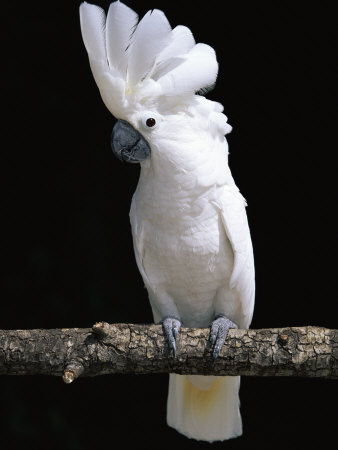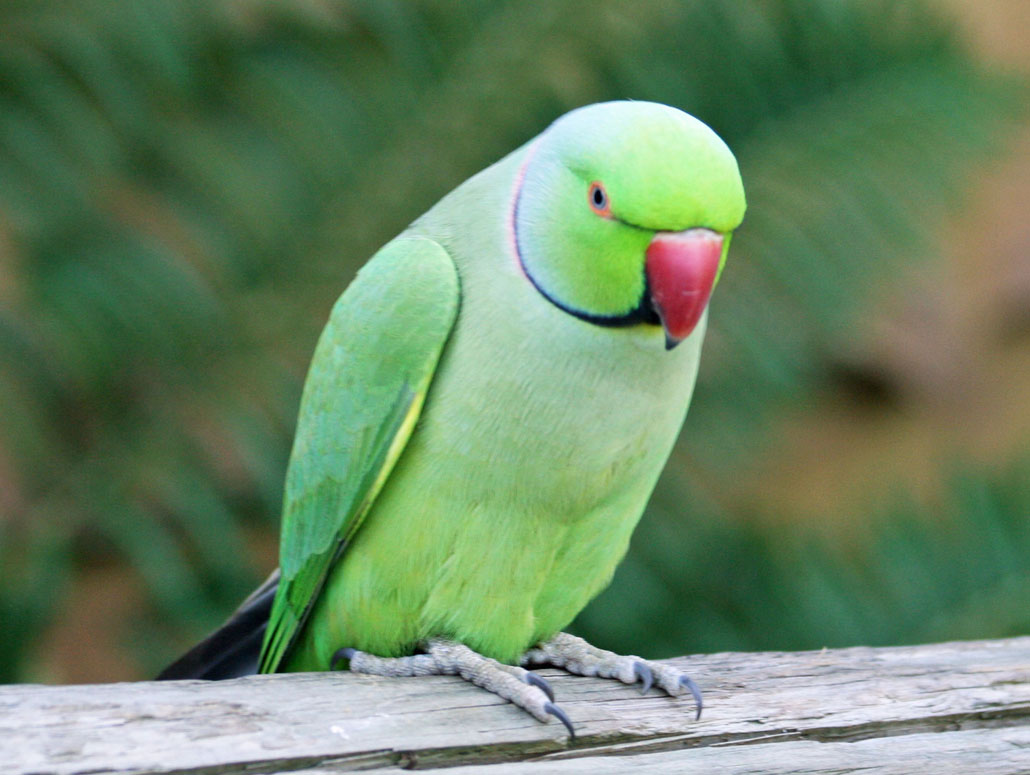hello everyone welcome Nour's blogspot my blogspot is about parrots
 african grey parrot: The African Grey Parrot also known as the Grey Parrot, is a medium-sized parrot found in the primary and secondary rainforest of West and Central Africa. Experts regard it as one of the most intelligent birds. They feed primarily on palm nuts, seeds, fruits, leafy matter, but have been observed eating snails. Their overall gentle nature and their inclination and ability to mimic speech have made them popular pets. This has led many to be captured from the wild and sold into the pet trade. The African Grey Parrot is listed on CITES appendix II, which restricts trade of wild caught species, because wild populations can not sustain trapping for the pet trade. As a pet, they must be kept entertained and busy with a person or toy or they may become stressed and begin self-destructive behaviour.
african grey parrot: The African Grey Parrot also known as the Grey Parrot, is a medium-sized parrot found in the primary and secondary rainforest of West and Central Africa. Experts regard it as one of the most intelligent birds. They feed primarily on palm nuts, seeds, fruits, leafy matter, but have been observed eating snails. Their overall gentle nature and their inclination and ability to mimic speech have made them popular pets. This has led many to be captured from the wild and sold into the pet trade. The African Grey Parrot is listed on CITES appendix II, which restricts trade of wild caught species, because wild populations can not sustain trapping for the pet trade. As a pet, they must be kept entertained and busy with a person or toy or they may become stressed and begin self-destructive behaviour.
 The Hyacinth Macaw or Hyacinthine Macaw, is a parrot native to central and eastern South America. With a length (from the top of its head to the tip of its long pointed tail) of about 100 cm (3.3 ft) it is longer than any other species of parrot. It is the largest macaw and the largest flying parrot species, though the flightless Kakapo of New Zealand can outweigh it at up to 3.5 kg. While generally easily recognized, it can be confused with the far rarer and smaller Lear's Macaw. Habitat loss and trapping wild birds for the pet trade has taken a heavy toll on their population in the wild, and as a result the species is classified as Endangered on the International Union for Conservation of Nature's Red List, and it is protected by its listing on Appendix I of the Convention on International Trade in Endangered Species of Wild Fauna and Flora (CITES).
The Hyacinth Macaw or Hyacinthine Macaw, is a parrot native to central and eastern South America. With a length (from the top of its head to the tip of its long pointed tail) of about 100 cm (3.3 ft) it is longer than any other species of parrot. It is the largest macaw and the largest flying parrot species, though the flightless Kakapo of New Zealand can outweigh it at up to 3.5 kg. While generally easily recognized, it can be confused with the far rarer and smaller Lear's Macaw. Habitat loss and trapping wild birds for the pet trade has taken a heavy toll on their population in the wild, and as a result the species is classified as Endangered on the International Union for Conservation of Nature's Red List, and it is protected by its listing on Appendix I of the Convention on International Trade in Endangered Species of Wild Fauna and Flora (CITES).
 The king parrots are three species of medium-sized parrots in the genus Alisterus; the Australian King Parrot (Alisterus scapularis), the Papuan King Parrot (Alisterus chloropterus), and the Moluccan King Parrot (Alisterus amboinensis). The three species are found in Eastern Australia, New Guinea, and Indonesian islands including the Maluku islands respectively. Predominantly of red and green plumage, the long tailed parrots are related to the genera Aprosmictus and Polytelis.
The king parrots are three species of medium-sized parrots in the genus Alisterus; the Australian King Parrot (Alisterus scapularis), the Papuan King Parrot (Alisterus chloropterus), and the Moluccan King Parrot (Alisterus amboinensis). The three species are found in Eastern Australia, New Guinea, and Indonesian islands including the Maluku islands respectively. Predominantly of red and green plumage, the long tailed parrots are related to the genera Aprosmictus and Polytelis.
 The Military Macaw is 70.5 cm (27.8 in) long on average, 99–110 (33–43 in) across the wings and weighs 900–1,100 grams (2–2.4 lbs).It is mostly green in color with the head a slightly paler shade. It bears a red frontal patch, with a white bare facial area barred with narrow black lines. The flight feathers are blue and the red tail bordered with blue. The large strong beak is grey-black and the iris yellow.
The Military Macaw is 70.5 cm (27.8 in) long on average, 99–110 (33–43 in) across the wings and weighs 900–1,100 grams (2–2.4 lbs).It is mostly green in color with the head a slightly paler shade. It bears a red frontal patch, with a white bare facial area barred with narrow black lines. The flight feathers are blue and the red tail bordered with blue. The large strong beak is grey-black and the iris yellow.
 african grey parrot: The African Grey Parrot also known as the Grey Parrot, is a medium-sized parrot found in the primary and secondary rainforest of West and Central Africa. Experts regard it as one of the most intelligent birds. They feed primarily on palm nuts, seeds, fruits, leafy matter, but have been observed eating snails. Their overall gentle nature and their inclination and ability to mimic speech have made them popular pets. This has led many to be captured from the wild and sold into the pet trade. The African Grey Parrot is listed on CITES appendix II, which restricts trade of wild caught species, because wild populations can not sustain trapping for the pet trade. As a pet, they must be kept entertained and busy with a person or toy or they may become stressed and begin self-destructive behaviour.
african grey parrot: The African Grey Parrot also known as the Grey Parrot, is a medium-sized parrot found in the primary and secondary rainforest of West and Central Africa. Experts regard it as one of the most intelligent birds. They feed primarily on palm nuts, seeds, fruits, leafy matter, but have been observed eating snails. Their overall gentle nature and their inclination and ability to mimic speech have made them popular pets. This has led many to be captured from the wild and sold into the pet trade. The African Grey Parrot is listed on CITES appendix II, which restricts trade of wild caught species, because wild populations can not sustain trapping for the pet trade. As a pet, they must be kept entertained and busy with a person or toy or they may become stressed and begin self-destructive behaviour.  The Hyacinth Macaw or Hyacinthine Macaw, is a parrot native to central and eastern South America. With a length (from the top of its head to the tip of its long pointed tail) of about 100 cm (3.3 ft) it is longer than any other species of parrot. It is the largest macaw and the largest flying parrot species, though the flightless Kakapo of New Zealand can outweigh it at up to 3.5 kg. While generally easily recognized, it can be confused with the far rarer and smaller Lear's Macaw. Habitat loss and trapping wild birds for the pet trade has taken a heavy toll on their population in the wild, and as a result the species is classified as Endangered on the International Union for Conservation of Nature's Red List, and it is protected by its listing on Appendix I of the Convention on International Trade in Endangered Species of Wild Fauna and Flora (CITES).
The Hyacinth Macaw or Hyacinthine Macaw, is a parrot native to central and eastern South America. With a length (from the top of its head to the tip of its long pointed tail) of about 100 cm (3.3 ft) it is longer than any other species of parrot. It is the largest macaw and the largest flying parrot species, though the flightless Kakapo of New Zealand can outweigh it at up to 3.5 kg. While generally easily recognized, it can be confused with the far rarer and smaller Lear's Macaw. Habitat loss and trapping wild birds for the pet trade has taken a heavy toll on their population in the wild, and as a result the species is classified as Endangered on the International Union for Conservation of Nature's Red List, and it is protected by its listing on Appendix I of the Convention on International Trade in Endangered Species of Wild Fauna and Flora (CITES).
Most Amazon parrots are predominantly green, with accenting colors that depend on the species and can be quite vivid. They feed primarily on seeds, nuts, and fruits, supplemented by leafy matter.
Many Amazon parrots have a remarkable ability to mimic human speech and other sounds. Partly because of this they are popular as pets or companion parrots, and a small industry has developed in breeding parrots in captivity for this market. This popularity has led to many parrots being taken from the wild to the extent that some species have become threatened. CITES treaties have made trapping wild parrots for the pet trade illegal to protect wild populations
 The king parrots are three species of medium-sized parrots in the genus Alisterus; the Australian King Parrot (Alisterus scapularis), the Papuan King Parrot (Alisterus chloropterus), and the Moluccan King Parrot (Alisterus amboinensis). The three species are found in Eastern Australia, New Guinea, and Indonesian islands including the Maluku islands respectively. Predominantly of red and green plumage, the long tailed parrots are related to the genera Aprosmictus and Polytelis.
The king parrots are three species of medium-sized parrots in the genus Alisterus; the Australian King Parrot (Alisterus scapularis), the Papuan King Parrot (Alisterus chloropterus), and the Moluccan King Parrot (Alisterus amboinensis). The three species are found in Eastern Australia, New Guinea, and Indonesian islands including the Maluku islands respectively. Predominantly of red and green plumage, the long tailed parrots are related to the genera Aprosmictus and Polytelis.
The White Cockatoo, Cacatua alba (also known as the Umbrella Cockatoo or U2), is a medium-sized, approximately 46 centimetres (18 in) long cockatoo endemic to the islands of Halmahera, Bacan, Ternate, Tidore, Kasiruta and Mandiole in North Maluku, Indonesia. This threatened white parrot has brown or black eyes and a dark grey beak. When surprised, it extends a large and striking crest, which has a semicircular shape (similar to an umbrella, hence the alternative name). Pet White Cockatoos may raise their crests upon training, or when something catches their interest such as a new toy or person. The undersides of the wings and tail have a pale yellow or lemon color which flashes when they fly.
The Rose-ringed Parakeet (Psittacula krameri), also known as the Ring-necked Parakeet, is a gregarious tropical Afro-Asian parakeet species that has an extremely large range. Since the trend of the population appears to be increasing, the species has been evaluated as Least Concern by IUCN in 2009.Rose-ringed parakeets are popular as pets. Its scientific name commemorates the Austrian naturalist Wilhelm Heinrich Kramer.
This non-migrating species is one of few parrot species that have successfully adapted to living in 'disturbed habitats', and in that way withstood the onslaught of urbanisation and deforestation. In the wild, this is a noisy species with an unmistakable squawking call.
The Military Macaw is a large parrot and a medium-sized member of the macaw genus. Though considered vulnerable as a wild species, it is still commonly found in the pet trade industry. A predominantly green bird, it is found in the forests of Mexico and South America.
 The Military Macaw is 70.5 cm (27.8 in) long on average, 99–110 (33–43 in) across the wings and weighs 900–1,100 grams (2–2.4 lbs).It is mostly green in color with the head a slightly paler shade. It bears a red frontal patch, with a white bare facial area barred with narrow black lines. The flight feathers are blue and the red tail bordered with blue. The large strong beak is grey-black and the iris yellow.
The Military Macaw is 70.5 cm (27.8 in) long on average, 99–110 (33–43 in) across the wings and weighs 900–1,100 grams (2–2.4 lbs).It is mostly green in color with the head a slightly paler shade. It bears a red frontal patch, with a white bare facial area barred with narrow black lines. The flight feathers are blue and the red tail bordered with blue. The large strong beak is grey-black and the iris yellow.
The Military Macaw appears superficially similar to, and may easily be confused with the somewhat larger Great Green Macaw.
The Red-tailed Black Cockatoo (Calyptorhynchus banksii), also known as Banksian- or Banks' Black Cockatoo, is a large cockatoo native to Australia. The species was known as Calyptorhynchus magnificus for many decades until the current scientific name was officially conserved in 1994. It is more common in the drier parts of the continent. Five subspecies are recognised, differing most significantly in beak size. Although the more northerly subspecies are widespread, the two southern subspecies, the Forest Red-tailed Black Cockatoo and the South-eastern Red-tailed Black Cockatoo are under threat.
Adult Red-tailed Black Cockatoos are around 60 centimetres (24 in) in length and sexually dimorphic. Males are completely black in colour, excepting their prominent red tail bands; the slightly smaller females are black with yellow barring on their chest, yellow grading to red spots over their crest, cheeks and wings and yellow-orange tail stripes. The species is usually found in eucalyptus woodlands, or along water courses. In the more northerly parts of the country, these cockatoos are commonly seen in large flocks. They are seed eaters and cavity nesters, and as such depend on trees with fairly large diameters, generally Eucalyptus. Populations in southeastern Australia are threatened by reduction in forest cover and other habitat alterations. Of the black cockatoos, the red-tailed is the most adaptable to aviculture, although black cockatoos are much rarer and much more expensive outside Australia.
Adult Red-tailed Black Cockatoos are around 60 centimetres (24 in) in length and sexually dimorphic. Males are completely black in colour, excepting their prominent red tail bands; the slightly smaller females are black with yellow barring on their chest, yellow grading to red spots over their crest, cheeks and wings and yellow-orange tail stripes. The species is usually found in eucalyptus woodlands, or along water courses. In the more northerly parts of the country, these cockatoos are commonly seen in large flocks. They are seed eaters and cavity nesters, and as such depend on trees with fairly large diameters, generally Eucalyptus. Populations in southeastern Australia are threatened by reduction in forest cover and other habitat alterations. Of the black cockatoos, the red-tailed is the most adaptable to aviculture, although black cockatoos are much rarer and much more expensive outside Australia.




No comments:
Post a Comment